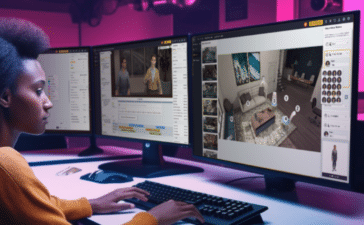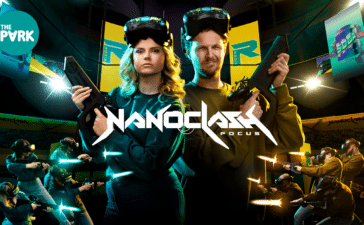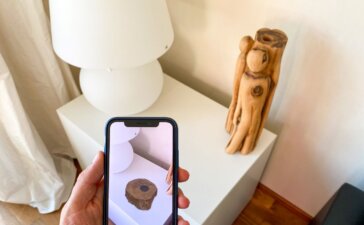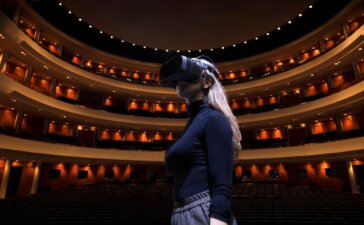After the COVID-19 pandemic made most event organizers cancel their live AR/VR events or host them virtually, in the past year more and more live events are making a comeback. Even the immersive industry needs a real-life environment to discover gadgets and try AR/VR content.
And we will tell you exactly where you should go if you want to try the most exciting discoveries and devices. Also, we know that if you work in this industry, you should not miss these AR/VR events, either. You have the great opportunity to network with peers or even discover new business or employment opportunities.
The Most Relevant AR/VR Events in 2023 You Should Not Miss
Here are some of the most important AR/VR events that are taking place until the end of this year.
1. AWE USA 2023
When: May 31 – June 2
Where: Santa Clara, CA, US; and virtual

Late spring/early summer is a great time to be in California. This year, it is made even better by one of the top AR/VR events: AWE USA. This is one of the most comprehensive fairs for professionals, stakeholders, and tech enthusiasts focused on immersive technologies.
They will be able to test various gadgets, discover content trends, and attend insightful keynote presentations. Attendees will be able to hear from a vast number of XR professionals, such as Peggy Johnson (the CEO of Magic Leap), Hugo Swat (Vice-President and General Manager of XR at Qualcomm), Chi Xu (CEO of Nreal), Elizabeth Hyman (CEO of XR Association), John Riccitiello (CEO of Unity), Kavya Pearlman (Founder & CEO of XR Safety Initiative), and many more.
For those who can’t attend in person, there’s also the option to access some parts of the event online through the awe.live platform.
As AWE USA 2023 media partner, ARPost offers its readers a 20% discount code. Use the code 23ARPOSTD during registration.
2. XR Expo 2023
When: June 15-16
Where: Stuttgart, Germany

If you happen to be in Germany this summer for business, you can also put aside two days to attend XR Expo 2023. This B2B event will bring together industry users, technology providers, content service providers, and XR researchers, and will focus on professional applications of extended reality technologies in health, industry, architecture, and trade and craft.
Right now, registration for XR Expo 2023 is open, but the event’s program is still under development.
3. Enterprise Metaverse Summit
When: June 28-29
Where: London, UK; and virtual

Another AR/VR event taking place in Europe, Enterprise Metaverse Summit is hosted by the British weekly newspaper The Economist. The event audience includes senior executives focused on XR, automation, IoT, 5G, the future of work, AI, machine learning, and edge computing.
This year’s event will cover a vast number of topics, from how the metaverse is expected to replace or improve human experiences at work, and how VR is making surgeries safer, to how the metaverse can help businesses become more sustainable and reduce their carbon footprint, and the benefits of VR as an engine to catalyze diversity and inclusion initiatives.
Attendees will be able to hear from speakers such as Meta Reality Labs’ VP Christine Trodella, Wallart’s Head of 3D Creative Technology Cynthia Maller, MetaVRse co-founder Alan Smithson, and EndeavorXR founder and CEO Amy Peck.
For all those who cannot attend, the event organizers offer a free virtual pass for full access to all virtual sessions on the first day of the event.
4. XR:WA
When: July 20-23
Where: Perth, Western Australia

Australian winter is mild compared to the summer heat in many parts of the US, so it’s a great moment to attend one of the best AR/VR events of the year. XR:WA is for everyone, from those curious to try immersive experiences for the first time to seasoned professionals.
The event aims to discuss the impact and opportunities for XR across a number of industries including architecture, design, medicine, education, training, science, art, and entertainment.
Back for its fifth edition, the event activities include talks, panels, various AR and VR experiences, workshops, a trade floor, and exhibition.
5. Industrial IMMERSIVE Week
When: August 28-30
Where: Houston, TX

Industrial IMMERSIVE Week is one of the AR/VR events for professionals interested in XR, spatial computing, digital twins, AI, IIoT, 5G, 3D models and simulations, and connected workforce solutions.
Touted as the event “where industry goes for real-world use cases, best practices and emerging tech for your enterprise to launch, pilot and deploy metaverse programs,” Industrial IMMERSIVE Week is intended for professionals from diverse industries, including manufacturing, construction, oil and gas, engineering, mining, automotive, aerospace, and logistics.
From C-suite leaders, to department leaders and professionals, Industrial IMMERSIVE Week brings together seasoned specialists and decision-makers. Some of the most important Fortune 500 companies will be represented at the event, including Boeing, Canon, Shell, Amazon, and Hewlett Packard Enterprise.
6. Augmented Enterprise Summit
When: October 24-26
Where: Houston, TX; virtual

As its name suggests, this AR/VR event is aimed at enterprises. Augmented Enterprise Summit is dedicated to the business and industrial applications of XR and other metaverse-related emerging technologies.
This year, the event boasts an impressive line-up of speakers including NASA’s Simulation and Graphics Capabilities Manager Angelica Garcia, CocaCola’s Director of Technical Training and Development Michael Whatley, Airbus Head of Augmented Worker Product Andreas Oeder, and Amazon Web Services Principal Spatial Computing Solutions Architect Kurt Scheuringer.
Among the sponsors and exhibitors, you can find a number of XR companies such as Mytaverse, RealWear, Strivr, and Vuzix.
Aside from more than a thousand expected attendees, the 10th Augmented Enterprise Summit will also feature over 50 exhibitors and sponsors, and more than 50 educational sessions.
The event also offers a virtual pass, with access to a virtual event app, digital exhibitor zone, exclusive post-event resources, and all sessions and on-demand recordings. As Augmented Enterprise Summit media partner, we can offer our readers 15% off for event tickets with the code arpost15.











































